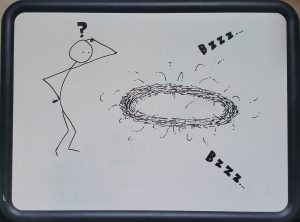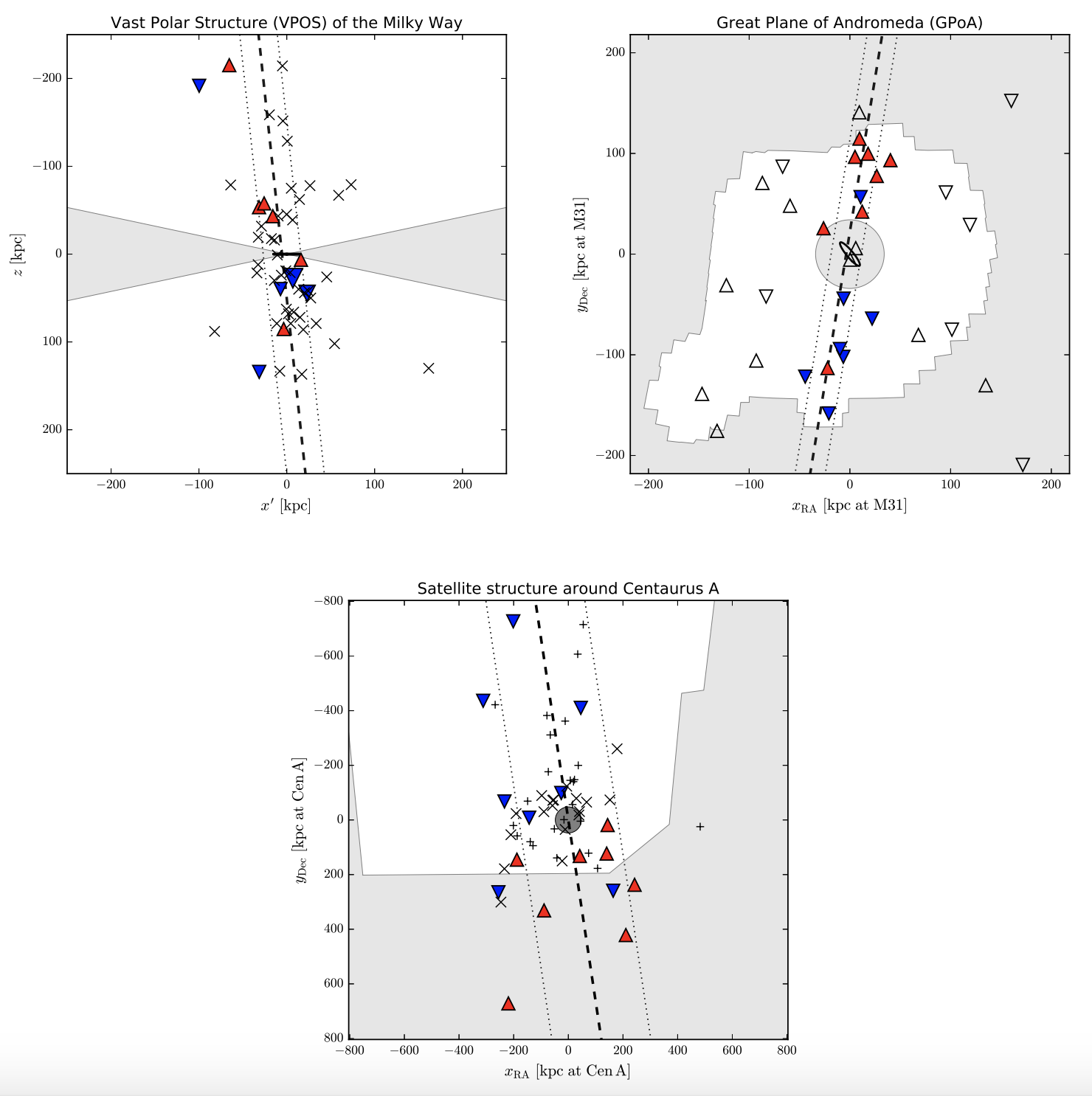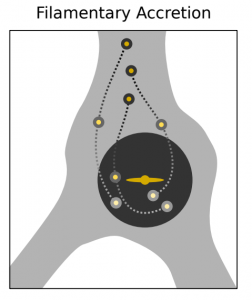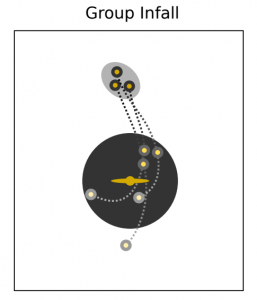Title: The Planes of Satellite Galaxies Problem, Suggested Solutions, And Open Questions
Authors: Marcel Pawlowski
First Author’s Institution: University of California, Irvine, USA
Status: Accepted to Modern Physics Letters A [open access at arXiv]
Imagine going for a walk in the summer and coming upon a swarm of bees in flight. But instead of buzzing around in a randomly-distributed cloud, many of the bees are flying in a tightly correlated disk or plane like the rings around Saturn. Not exactly what you’d expect to see, right? (See Figure 1.)

Figure 1: A very suspicious swarm of bees. Illustration by me.
Something similar is happening in the universe. (Except with dwarf galaxies instead of bees.) Large galaxies like our Milky Way are surrounded by swarms of smaller satellite galaxies. In simulations of galaxy formation made using the standard model of cosmology, the Lambda Cold Dark Matter model (ΛCDM), these satellite galaxies end up orbiting mostly randomly. That is to say, you generally wouldn’t expect to find multiple satellite galaxies having orbits similar to each other and orbiting in the same direction. However, observations of the Milky Way, the Andromeda Galaxy (M31), and the relatively nearby galaxy Centaurus A have revealed the presence of large, coherent planes of satellite galaxies orbiting around all three. And not only are many of the satellites orbiting in a plane, but in each case the majority of the galaxies in the plane are also orbiting in the same direction. (See Figure 2 for an overview of the various planar structures around the three galaxies.)

Figure 2: An illustration of the planes of satellite galaxies around the Milky Way (top left), M31 (top right), and Centaurus A (bottom). Colored triangles indicate satellites that are part of the planar structure; blue indicates approaching galaxies and red indicates receding galaxies. Galaxies that are known to not be part of the plane, or are not known to be part of it, are denoted by open triangles and X’s. Figure 1 in the paper.
The Problem: Comparison to Simulations
The interesting part of all this is that in the best simulations we have right now such tightly correlated satellite galaxy planes are extremely rare. To measure just how rare Pawlowski searched two large simulations, the Exploring the Local Volume in Simulations (ELVIS) suite and Millennium-II, for galaxies comparable to the Milky Way, M31, and Centaurus A. He then looked at their satellite galaxies to see how they compared to what we observe in nature.
The result? Planes of satellite galaxies turned out to be extremely unlikely, showing up in a mere 0.1% (Millennium-II) to 0.5% (ELVIS) of galaxies. This might not be a problem if we only knew of one such structure, but we now know of three in the local universe which is significantly more than we’d expect to find based on these simulations. This discrepancy is known as the Planes of Satellite Galaxies Problem, and has been suspected for a number of years now (see for instance this earlier Astrobite).
Possible Solutions
Pawlowski considered three possible solutions that have been put forth to address this outstanding question, but concluded that all three have their own problems:
- Filamentary Accretion (Figure 3). In the ΛCDM model large galaxies form at the intersection of dark matter filaments. Smaller dwarf galaxies form in and along those filaments and end up infalling towards larger galaxies to be caught in their gravitational embrace. If enough galaxies infall from the same filament, perhaps this could account for what we see. Unfortunately the sheer number of correlated galaxies doesn’t add up, and dwarf galaxies infalling from filaments should already be accounted for in the simulations.

Figure 3. Multiple dwarf galaxies falling from the same direction along a dark matter filament, thus producing correlated orbits. Panel one of three from Figure 3 in the paper.
- Group Infall (Figure 4). A similar solution involves dwarf galaxies forming in groups that then all infall together, forming coherently orbiting groups. Again, the number of galaxies involved in these planes makes this highly improbable. (For example, around M31 fifteen out of twenty-seven known satellite galaxies are found in The Great Plane of Andromeda.) Plus, like filamentary accretion, this behavior should already be accounted for in the simulations.

Figure 4. A group of dwarf galaxies that formed together all infalling towards a large galaxy. Panel two of three from Figure 3 in the paper.
- Tidal dwarf galaxies (Figure 5). A third, somewhat more-promising possibility is that the dwarf galaxies involved in these structures are actually tidal dwarf galaxies formed from gas pulled from the central galaxy in a close encounter. This would easily explain why they all travel in similar orbits. The Milky Way and M31 may have tidally interacted in the past and Centaurus A shows clear signs of having had a major interaction so this hypothesis sounds sensible. However, it turns out that there should be major differences in the dark matter content of tidal dwarf galaxies, which should have no dark matter, versus regular dwarf galaxies, which should be dominated by it. However, observations so far show no sign of two different dwarf galaxy populations so this doesn’t seem to be the answer either.

Figure 5. A group of dwarf satellite galaxies formed from gas tidally pulled out of the central large galaxy after a close interaction with another galaxy. Panel three of three from Figure 3 of the paper.
Conclusion: Still an Open Question
So there we have it: dwarf satellite galaxies are too orderly. Pawlowski concludes that at this point it remains an open question how these planes of satellite galaxies are formed. This suggests work for theoreticians, simulation authors, and observers: theoreticians can start working on modeling these planar structures, simulation authors can figure out how to incorporate them into simulations, and observational astronomers can search for more such structures around other galaxies to better understand just how common these things are in the universe. Definitely an exciting problem for astronomers to solve!




